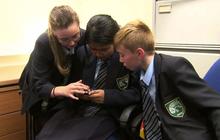Youngest kids may be narrowing the “digital divide”

It’s no longer surprising to see a toddler barely old enough to walk or talk intuitively start swiping the screen of a smartphone. More American children are getting comfortable using mobile technology at younger ages.
And according to new research, that’s not only true of financially well-off families. A new survey of parents from a low-income, minority, urban community found exposure to mobile media devices is “almost universal” among children by the age of 4, and most kids start using them before their first birthday.
For the study, researchers from Albert Einstein Medical Center, in Philadelphia, collected data from Philadelphia parents on 350 children between the ages of 6 months and 4 years old. The parents answered anonymous survey questions while waiting to see health care providers.
Results showed that most households had televisions (97 percent), tablets (83 percent), and smartphones (77 percent).

Kids with cell phones: How young is too young?
The study authors also wanted to learn more about how often and at what age little ones are beginning to use mobile devices, said study author Dr. Matilde Irigoyen, chair of the Department of Pediatric and Adolescent Medicine at Albert Einstein Medical Center.
“We looked at how young children, ages 4 and under, used mobile media,” said Irigoyen. “I was surprised by some of the findings.”
She said while it wasn’t news to learn that young children use mobile devices, she and colleagues were surprised by how frequently they used them and how many had their own personal devices.
By age 4, half of the children had their own television and three-quarters had their own mobile devices. The most popular device was a tablet, owned by two-thirds of 4-year-olds.
“We were also surprised to see how many of them used it without assistance. By [age] 3 and 4, half of the children could use mobile devices without any help. They become very skilled very soon,” Irigoyen told CBS News.
Most children started using mobile devices in their first year of life, and use was enabled by parents who gave children a device to use and to keep, the authors reported.
Three out of four parents doled out a mobile device when doing chores and to keep children calm when they were out in public places, and while running errands. About a quarter of them used mobile devices to help put their child to sleep, twice the rates reported in a 2013 Northwestern University national survey.
Dr. Wendy Sue Swanson, executive director of Digital Health at Seattle Children’s Hospital, said children are growing up in a digital age and are interacting with screens as a part of their everyday lives.
“More than ever, we have to continue as parents and as a community to be thoughtful about how we curate our kids’ use of devices, not so much finger-wagging,” said Swanson.
Devices will always capture their attention, so parents need to be asking about and seeing what’s on a device and co-viewing with their kids as they grow up, even into the teen years, said Swanson. She noted that there are thousands of “educational” apps, but not all of them are actually beneficial, so these should be vetted carefully.
Moms and dads also need to be clear about setting tech-free zones, and bedtime should remain one of those sacred places.
“The study showed kids are getting handed a device at bedtime and that’s where I think screens can be really detrimental to health. Bedtime rituals are precious – reading, singing, being with family. And bedtime rituals are really important to good sleep hygiene,” Swanson said.
The study was not intended to look at the impact of device use – it just describes the patterns of use, the authors wrote. They also noted that compared with data from 2013 nationwide surveys, their research found significantly increased access to mobile devices in the low-income community, suggesting a rapid decline of the “digital divide” between low-income and wealthier families.
“Possible contributing factors are decreasing costs and subsidies by cellular service providers,” said study author Irigoyen.
Future research could explore many questions this study raises, she said, such as how parents utilize devices at bedtime. “An interesting question is what are parents doing when they put children to sleep with devices?”
More studies are also needed to update guidelines and recommendations for mobile media use by young children, the authors said.












